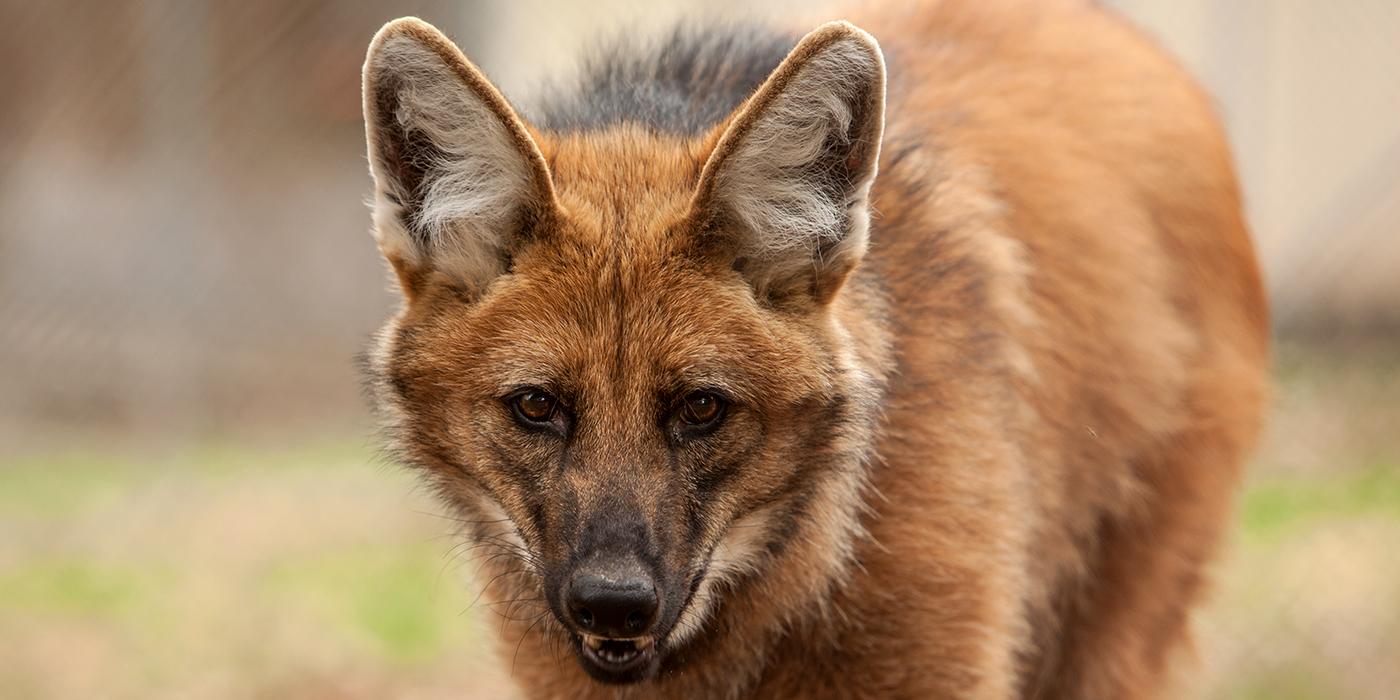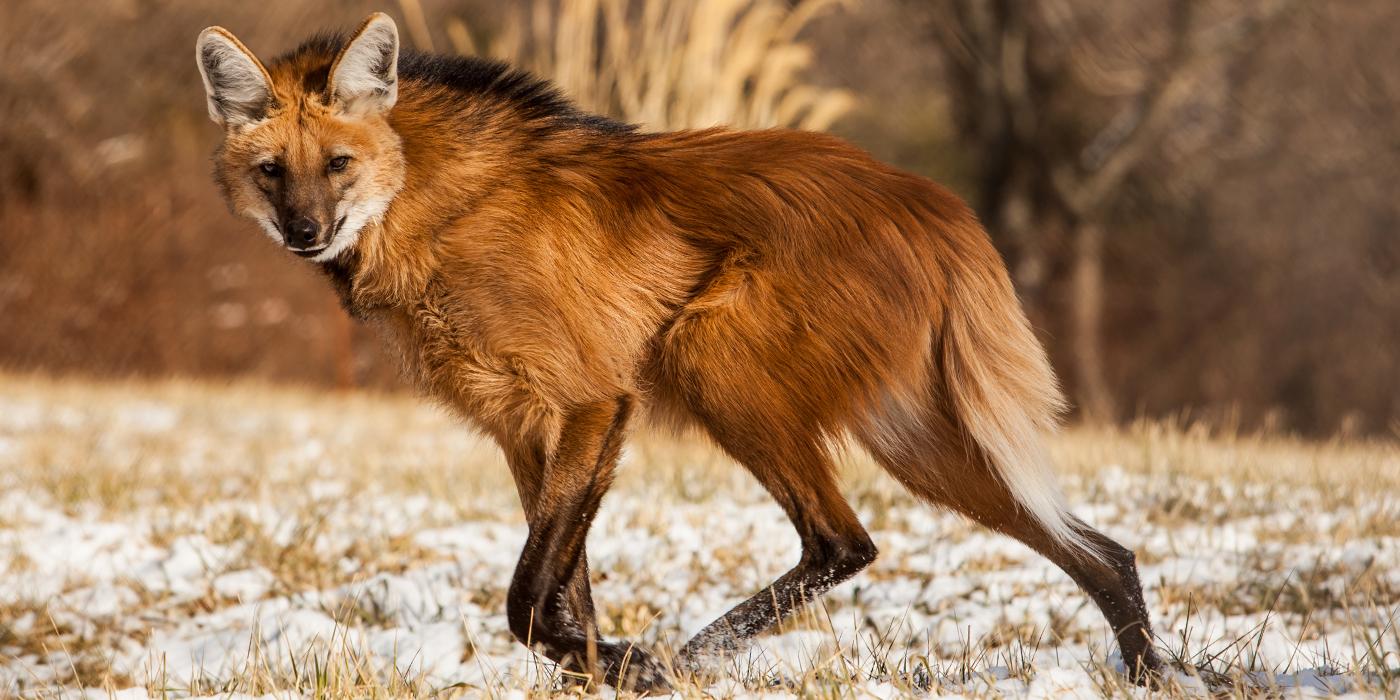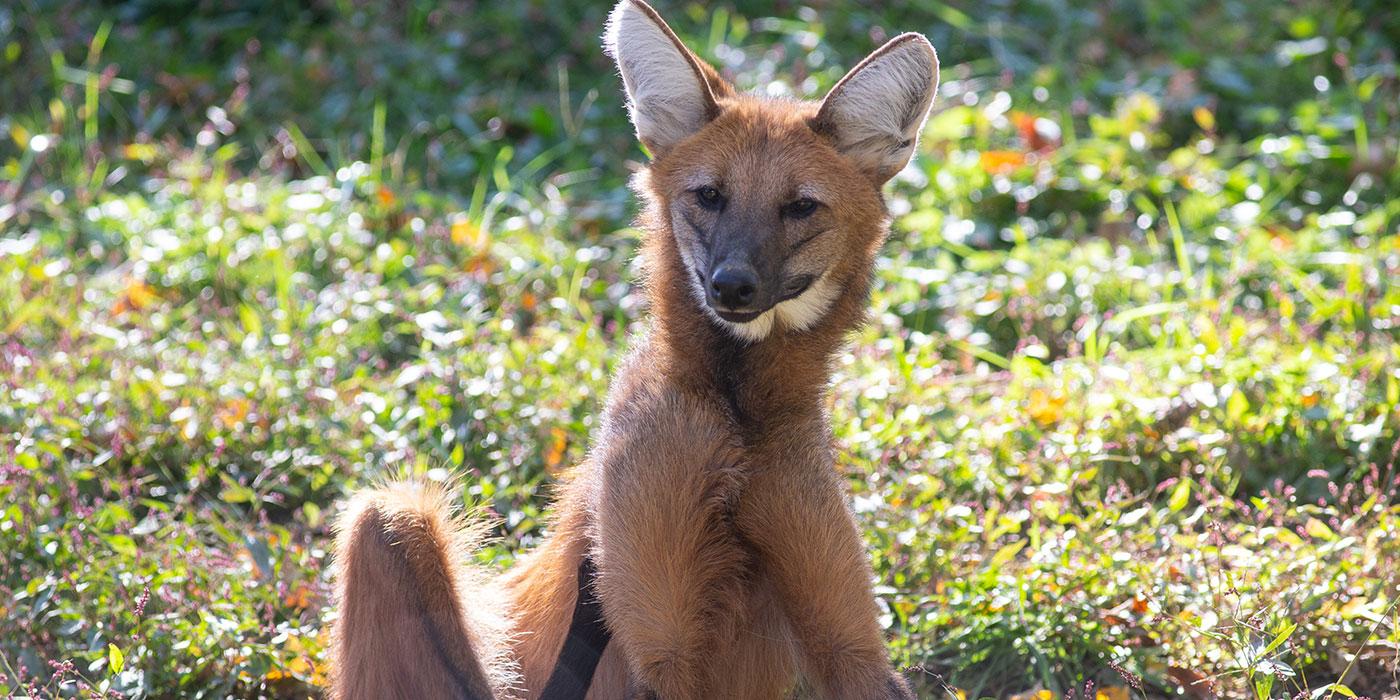Physical Description
Having evolved to live in high grass savannas, maned wolves have a thick red coat, long black legs and tall, erect ears. The maned wolf is the largest canid of South America. It looks more like a long-legged fox than a wolf. Genetic studies show that it is neither fox nor true wolf, but a distinct species. It is the only member of its genus, Chrysocyon.
Size
The maned wolf stands about 3 feet (90 centimeters) tall at the shoulder and weighs about 50 pounds (23 kilograms).
Native Habitat
Maned wolves range through central and eastern South America including northern Argentina, South and Central Brazil, Paraguay, Bolivia and southern Peru. They inhabit the cerrado, the largest biome of South America, which is composed of wet and dry forests, grasslands, savannas, marshes and wetlands.
Lifespan
The life span of maned wolves in the wild is unknown. In human care, median life expectancy is 6.5 years with a maximum of 12 to 15 years.
Communication
Maned wolves mark their territory with powerful-smelling urine and feces on hillocks and termite mounds along their borders. They do not howl, but instead emit loud barks or roar barks to let their mate know where they are, and to warn other wolves to stay away.
Food/Eating Habits
Maned wolves are omnivorous eaters and primarily solitary hunters. They eat seasonally abundant fruits and vegetables and are particularly interested in lobeira, whose name means "fruit of the wolf." It is a small tomato-like berry that, along with other fruits and vegetables, makes up 50 percent of the maned wolf's diet.
They eat small mammals such as rodents, rabbits and insects. Maned wolves rotate their large ears to listen for prey animals in the grass. They tap the ground with a front foot to flush out the prey and pounce to catch it, or they may dig after burrowing prey. They may also leap into the air to capture birds and insects. Long legs help them move through and see above tall grasses.
Maned wolves share their habitat with a wide variety of other carnivores: bush dog, crab-eating fox, hoary fox, pampas fox, puma, jaguar, pampas cat, jaguarondi, crab-eating raccoon, hog-nosed skunk and grison. Because of their large size, only the puma and domestic dogs have been reported to kill the maned wolf.
At the Smithsonian's National Zoo, maned wolves are fed Mazuri Maned Wolf diet, vegetables, mice and occasionally beef bones for treats. Each wolf eats two pounds of food each day.
Sleep Habits
Crepuscular to nocturnal.
Social Structure
Maned wolves live in monogamous pairs sharing a 10 square mile (26 square kilometer) territory.
Reproduction and Development
Females enter estrus once a year for approximately five days. Males only produce sperm during the breeding season as well. Peak breeding in the wild is from April to June. Vocalizations and scent marking increase before mating.
Most information on maned wolf breeding has come from the study of animals in human care. Scientists have found that the mean number of pups produced is 2.5 (with a range of 1 to 5) with a gestation period of 65 days. Females are responsible for raising pups, but there is evidence that males provide food to their pups in both zoo and wild populations. The pups nurse for four weeks at which point the mother introduces regurgitated food. Pups generally leave the parents' territory at one year of age.
Conservation Efforts
The IUCN Red List of Threatened Species lists maned wolves as near threatened. However, the Brazilian Red List and the U.S. Fish and Wildlife Service Endangered Species List lists maned wolves as endangered. The total population is believed to be below 5,000 outside of Brazil. Habitat analysis suggests that as many as 20,000 may remain in Brazil.
Habitat destruction for agriculture and highways is the main threat to maned wolves. The cerrado has been reduced to 20 percent of its original size. General disregard for speed limits leads to significant traffic fatalities. Sometimes maned wolves are killed for their body parts, which are believed to have magical properties. Domestic dogs pose threats through direct persecution and disease transmission.
The Zoo has been working to protect maned wolves for nearly 30 years and coordinates the Maned Wolf Species Survival Plan, which includes breeding maned wolves, studying them in the wild, protecting their habitat, and in situ education programs.
Maned wolves in human care are susceptible to all of the common viruses of the domestic dog. Current Smithsonian research is focusing on the threats of domestic dog diseases to the wild populations. The typical wild wolf has only one functioning kidney, the right kidney having been destroyed by the effects of the giant kidney worm.
Many maned wolves in human care suffer from cystinuria, a metabolic disorder in which the amino acid cystine is not reabsorbed by the renal system. Cystine has the potential to precipitate out and form "sand" or calculi in the kidney and or bladder and cause blockages or ruptures. The major push behind diet research for maned wolves is the attempt to find a diet that will raise their urinary pH, thus preventing the formation of stones and excreting the excess cystine.
Help this Species
Support organizations like the Smithsonian’s National Zoo and Conservation Biology Institute that research better ways to protect and care for this animal and other endangered species. Consider donating your time, money or goods.
Are you a student? Did you love what you learned about this animal? Make it the topic of your next school project, or start a conservation club at your school. You'll learn even more and share the importance of saving species with classmates and teachers, too.
Try fundraising for conservation organizations in new and fun ways. You could donate your birthday to conservation, or host a bakesale to benefit wildlife!
Smithsonian's National Zoo and Conservation Biology Institute. (n.d.). Maned wolf. Retrieved November 30, 2025, from https://nationalzoo.si.edu/animals/maned-wolf
Animal News

Giant Panda Qing Bao Gets a Checkup ›

7 Spooktacular Animal Facts for Halloween ›



